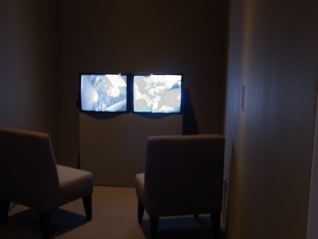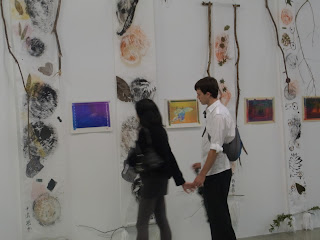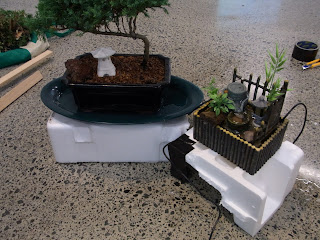
When: Friday 4 March - Sunday 6 March, 2011
Location: Interdisciplinary Unit, AUT University, Auckland
Building on a philosophical approach to technology and consumption and informed by Taoist concepts and ecological concerns, Ko Nakajima and Kentaro Taki will lead a three day workshop focussing on the collaborative development of work by the participants. The workshop will explore the ways in which redundant and abandoned equipment can be combined with cutting edge video and mobile media such as cellphones / iphones, still & video cameras, and Mp3 devices to explore the continuum of technological development and consumption in relation to our social and natural environment.
The workshop places have been filled
Artists:
Ko Nakajima (b. 1941) is one of Japan’s original video artists. Nakajima started working in film animation in the 1960’s before changing to video in 1970. In 1983, he invented the ANIPUTER in collaboration with JVC, a Time-lapse Video System that made it possible to cut out images and animate them. His video practice spans over 40 years and continues to be celebrated with exhibitions and installations both in Japan and internationally.
Nakajima was the first internationally acclaimed video artist to be invited to New Zealand in 1988, for a Television New Zealand commission to create a computer-graphic video piece for the Kaleidoscope art programme series. He produced a work titled RANGITOTO, the first ever video-art work to be broadcast, full length, on New Zealand national television. Nakajima is an artist who continues to push boundaries and attract wide critical acclaim.
Nakajima is an experienced media teacher who has worked at the Faculty of Media Art, Musashino Art University, Tokyo, Japan since 2003. He has delivered workshops internationally, including a workshop as part of the video art cultural exchange with Canada in 1981, and a workshop at the International Video festival Video-Nale, in Bonn, Germany in 1989.
Kentaro Taki (b. 1973) is a younger generation artist and a protégé of Ko Nakajima, who is similarly attracting wide, international attention for his inventive and individualistic video installations and performances. One of the main themes of Kentaro Taki’s work is the effect of communication media on society. Significant recent videos include Media Cage (2001), a critical reflection on the homogenisation of society, and Exchangeable Cities (2002), which is about the consequences of globalisation. In the latter work, Taki uses elements from different cities around the world to create the image of an unreal city. He developed an installation version of Media Cage, in which images of the visitors caught on eight video cameras, mix with randomly generated urban images and sounds, texts and geometric patterns. Taki is the Director of the Videoart Center Tokyo.
Taki is a lecturer in media art at the Kawaguchi Art School of Waseda University. The international workshops he has led include Media Assemblage at Digiark, National Museum of Taiwan in February 2010; Field work/Finding Mediascape in urban space at Tokyo Zokei University, Shibuya, Japan in November 2009 and Media Assemblage at Center of Multimedia, Mexico City in March 2009.
Ko Nakajima and Kentaro Taki
01 March - 25 March, 2011
Performance: 5 March, 7:30 – 9pm ST PAUL St Gallery
Artist Talk: 8 March, 5:30 pm AUT Lecture Theatre WE230
Ko Nakajima, one of Japan’s most innovative and respected video and performance artists, and his protégé Kentaro Taki offer a fascinating view of the historical and contemporary faces of Japanese video art, highlighting its unique sensibilities and aesthetics. Curated by intermedia artist Phil Dadson in asociation with ST PAUL St Gallery, Video Life is both a meditation and a provocative presentation of video technology’s impact on contemporary society.
Ko Nakajima (b.1941, Japan) first visited New Zealand in 1988 to create a work for Television New Zealand’s arts program Kaleidoscope. He produced a work titled
RANGITOTO, the first ever video-art work to be broadcast, full length, on national television. Nakajima returns to Auckland in 2011 to create a major new installation
Electric Luminance Performance at ST PAUL St. Combining Taoist philosophy and the natural environment with new and obsolete video technology, his installation will transform the gallery. Alongside this work he will present drawings and his ongoing piece
My Life 1976 - 2010, earlier versions of which were shown at the Museum of Modern Art, New York in 1976 and 1981.
Kentaro Taki (b.1973, Japan) represents a younger generation of Japanese video and performance artist. His work explores the impacts of mass communication and globalisation on contemporary society. Taki will present several works at ST PAUL St including
Living in the Box and a new version of his acclaimed video installation
Bild:Muell previously shown at the National Art Gallery Malaysia 2010, the Asian Art Biennial at the National Taiwan Museum of Fine Arts 2009 and the Tokorozawa Biennial of Contemporary Art, Japan, 2009.
Both artists will be present during the opening week of the Arts Festival and will present a performance evening with live video, dance and sound performances in collaboration with New Zealand performers on the 5th of March.
Performance: 5 March 7:30 – 9pm ST PAUL St Gallery
Ko Nakajima and Kentaro Taki will present two unique live performances at ST PAUL St. Ko Nakajima will work in collaboration with Phil Dadson and other New Zealand musicians and butoh dancers to create a live performance work responding to and activating his new work
Tao Installation. Kentaro Taki will present a live video performance combining analogue and digital processes. Informed by an idea of finding a path to an artwork through a process rather than becoming attached to an outcome Taki will attempt to find his way through a barrage of media to create his performance.
Workshop 4 – 6 March AUT, Interdisciplinary Unit Studio WT005
Cost: $50
Building on a philosophical approach to technology and consumption and informed by Taoist concepts and ecological concerns, Ko Nakajima and Kentaro Taki will lead a three day workshop focussing on the collaborative development of work by the participants. The workshop will explore the ways in which redundant and abandoned equipment can be combined with cutting edge video and mobile media such as cellphones / iphones, still & video cameras, and Mp3 devices to explore the continuum of technological development and consumption in relation to our social and natural environment.
Click here to download the
flyer and
application form. Applications are due by January 31, 2011
You can fill out the form and return it to us using Adobe Acrobat by clicking "submit by email" or save a copy of the completed form and email it to us as an attachment at
stpaul.gallery@aut.ac.nz


























































